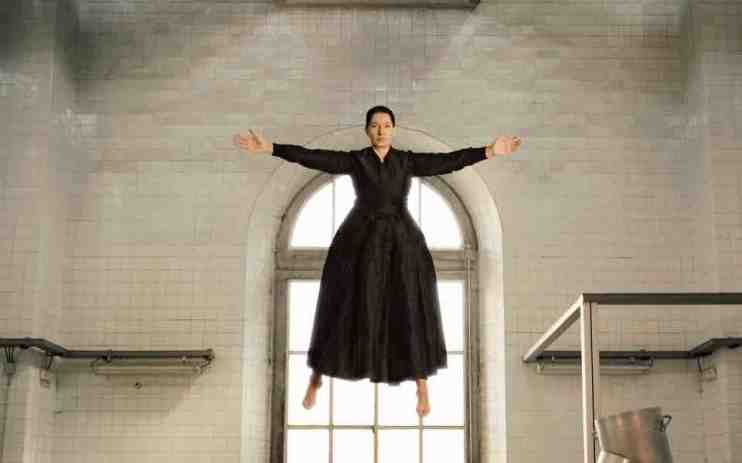Marina Abramovic at the Royal Court: As harrowing and vital as ever

Picasso with cubism, Basquiat with graffiti Andy Warhol with pop art. Marina Abramovic, perhaps the most famous performance artist who ever lived, long ago joined that vanishingly small circle of artists whose work has come to define an entire movement.
A new retrospective of her work, which snakes through the galleries of the Royal Academy, drills home (sometimes literally) exactly why the Serbian artist was such a vital, pioneering force.
It’s all here. There’s the laden table from her infamous Rhythm 0 from 1974, for which Abramovic presented a smorgasbord of terrifying implements – knives, axes, a gun – and invited visitors to use them on her however they saw fit. Initial coyness soon gave way to the darkest aspects of human nature, with people cutting her skin, slashing away her clothing and even holding a gun to her neck. The artist, then in her mid-twenties, claimed some of her hair turned permanently white from the trauma.
This legendary piece encapsulates the driving force in her early work: a visceral desire to test the limits and extremes of interaction, to explore what it means to be one human in the presence of another, and to coax out the animalistic instincts that lie behind our facades.
“I cannot do anything without an audience,” she once said. “I need their energy.”
There is, of course, nakedness. While Abramovic herself isn’t present for the show, nude life models people the exhibition. There are a pair flanking a narrow doorway who you can squeeze yourself uncomfortably between, breasts brushing against jackets, a penis grazing your suit trousers. Elsewhere a naked woman lies beneath a human skeleton – a neat, existentialist rumination on life and death – recreating a video piece from Abramovic that plays on a screen below.
The curation is stunning. One gallery, exploring her relationship to the communist rule where she grew up in the former Yugoslavia, is painted deep red and dominated by a giant pile of bones, taken from a piece where Abramovic sat atop a mountain of bloodied remains and attempted to wash them clean. In the same room are stills from performances in which she lay at the centre of a burning Communist star, having already carved the symbol into her stomach. The heat and smoke caused her to lose consciousness; Marina Abramovic was not messing around.
These works are famous in their own right, but seeing them collected – the video of her and a partner holding a taught bow and arrow aimed directly at her heart, Abramovic and a man repeatedly slapping each other’s faces – show just how much, and how often, she was willing to suffer for her art
There’s a striking disconnect between her youthful, haunting beauty and the agonies she put herself through. In later years the short, sharp shocks turned into feats of attrition. For one piece she sat day after day for three months at the MoMA in New York, inviting visitors to sit opposite her in intense silence (I attended a similar performance at the Serpentine Gallery). In another she created a prison cell in a gallery, where guests could watch as she survived on only water for 12 days in complete silence. Abramovic says she was attempting to find a place beyond physical and mental exhaustion, and by the end she was able to see the “auras” of the gathered crowds.
A lot of her work is about auras, in fact. While the guns and knives and self mutilation are what most people remember, she’s also partial to a bit of spiritualism. She travelled the world learning about the esoteric practices of different cultures, devoting years of her life to the study of energies and vibrations. Here she loses me somewhat.
While there’s physical presence to pieces like Portal, a glowing doorway rimmed by glowing crystals, and a sterile kind of beauty to the photographs of her lying on a beach surrounded by crystals, they don’t seem to impart any great insight into the human condition. An artist can, of course, redefine themselves in later life – think Henri Matisse with his cut outs – but these feel like a cul-de-sac rather than a fresh perspective.
Not that they detract from this stunning body of work, a harrowing, often grim celebration of an artist who pushed boundaries as far as anyone in search of meaning amid the madness of humanity.
